NorthEast Radio Watch 12/8/2025: Cichon’s Back in Buffalo
In this week’s issue… Veteran newsman returns - Remembering NY's Leitner, RI's Jones - CT AM saved - Maine AM moves - "Indie" adds suburban signals
Text and photos by SCOTT FYBUSH
Once a month, something cool happens across upstate New York: some engineer or equipment salesperson gets to make the long slog down the Thruway to be the speaker at four consecutive Society of Broadcast Engineers chapter meetings over three days, starting in Buffalo, then Rochester and Syracuse (both on the same day), and then Albany.
Last November, that lucky guy was me, and of course I couldn’t resist getting some broadcast tourism into the mix. After Syracuse on night 2, I drove through the night to Oneonta, just so I could get up early the next morning and chronicle a little bit of broadcast history over in Walton. (That would have been Ron Galley’s last day after more than 40 years at WDLA, and you heard our interview on the Top of the Tower Podcast last November.)
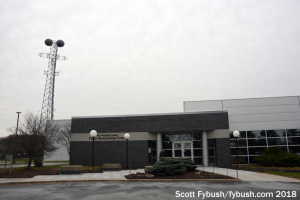

After that, we raced up I-88 and across the Hudson River to Rensselaer to screech into the parking lot of public broadcaster WMHT just as the nice folks of SBE Chapter 58 were finishing up lunch and waiting to hear my talk.

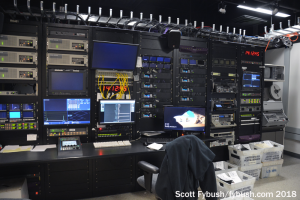
And of course once the talk was done, I couldn’t leave the building at 4 Global View without getting the nickel-plus tour of the place.
WMHT moved in here 15 years ago, leaving behind digs in a ramshackle building in Rotterdam that it had occupied since at least the early 1970s. (It started, as so many fledgling educational stations did, in a school building in Schenectady, down in the basement, way back in 1962.)
After initially planning to build a brand new building here at the Rensselaer Technology Park, WMHT ended up instead taking over an existing office building that had belonged to a digital mapping company, adding on a new TV studio facility to the remodeled office building.
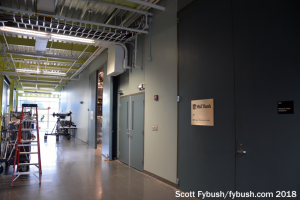

Today, once you head past the lobby (which still has an inlaid bronze marker from the mapping company noting the precise coordinates of the spot), you walk past the conference room where the SBE chapter met, then down a hallway where the TV station’s master control once sat. Those functions are now centralized in Syracuse for all of the state’s public broadcasters, so it’s now an edit room in that space. Beyond that is what remains of the TV engineering core, and beyond that is the new wing with the TV studios.
There are two of them here, plus a large scenery/storage area; we only got to see one because the other was in use by one of WMHT’s two radio stations, where a music performance and interview were underway behind closed doors.


The radio stations sit across the long hallway that runs down the length of the building, and the pair of mirror-image studios at the core of the radio area are actually shared between both stations, which do a lot of tracking of their music formats.
Classical WMHT-FM (89.1) is the bigger and older signal, having been around since 1972 from the old Rotterdam studios and now from here. (It’s also heard to the south in the Hudson Valley over relay WRHV 88.7 from Poughkeepsie.) The newer entrant here is WEXT (97.7), whose AAA format runs on that Amsterdam-licensed signal at the western edge of the metro – and which added an Albany/Troy translator on 106.1 not long after our visit.
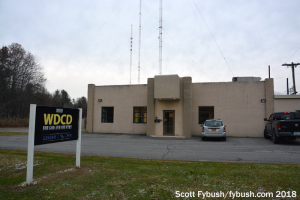
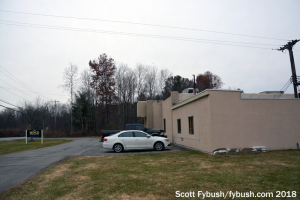
After our WMHT visit, with a blizzard warning looming, we rushed west to make one more “maybe we’ll never get here again” visit to a site we should have seen a long time ago.
We’d driven by 4243 Albany Street in Colonie, just west of Albany, many times over the years – but this was our first visit since the longtime occupant of the site had fallen silent. This was a venerable site, indeed: the old WPTR (1540) had signed on from here back in 1953, sending 50,000 big watts eastward over Albany and New England while somehow failing to be very audible in Schenectady, just a few miles to the west.
(Things you learn from reading FCC history cards: when the CP was granted in 1947, the new 1540 originally wanted to be WNYS. Not only did Schenectady’s WSNY complain about the similarity, the State of New York actually registered an objection, too, presumably with the idea that some listener somewhere would think the new WNYS was operated by New York State. And so those calls went unused for another 15 years until they ended up on a TV station in Syracuse…)
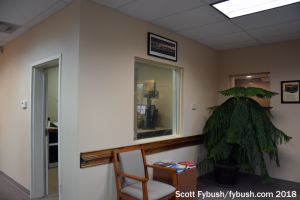
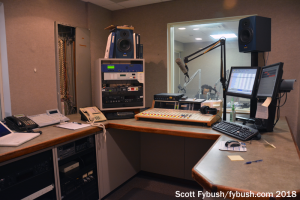
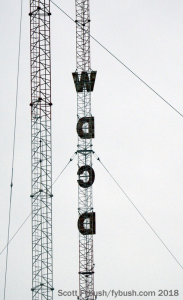
WPTR rose and fell over the decades that followed. It was a pretty big top-40 voice in the sixties, moving its studios out here and adding a big metal prefab building next to the 1950s-era stucco transmitter.
As FM grew and AM waned, WPTR’s signal became more of a liability than an asset; by the 1990s, it had been sold to Crawford Broadcasting and gone to religious programming as WDCD – and then even Crawford migrated to the FM dial, buying a newer FM signal that became WDCD-FM (96.7 Clifton Park).
The newer metal building was eventually taken down as operations consolidated back into the original building. For years, Crawford tried to keep the big AM signal going. They even put up new “WDCD” call letters on the north tower to replace the WPTR callsign that had faced out toward Route 5 traffic for decades.
It couldn’t last forever, though; after trying and failing to find a buyer for the AM, Crawford eventually shut down the AM 1540 signal. When we stopped by in November 2018, the transmitter room across the back of the building was quiet and dark, its row of equipment awaiting a buyer who might move it elsewhere.
(It had been rebuilt over the years as studio and transmitter room moved around the complex; at our visit, it was anchored by a phasor at one end, a Nautel ND-era 60 kW transmitter, an auxiliary 12 kW AMPFET, plus the STL and processing and networking for WDCD-FM, which then remained on the air. As you’d expect for anything Crawford, all the gear was in impeccable condition.)
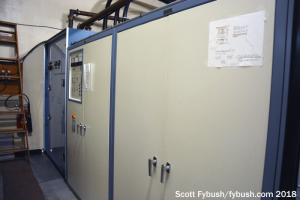
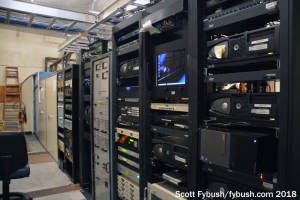
Since our visit last year, the AM 1540 license was finally allowed to expire. The FM station, which was operating on a shoestring staff from the small office/studio complex at the front of the building (which had been rebuilt by Crawford after the larger metal building was torn down), was itself sold off in recent months. It’s now WMHH, a satellite of the Mars Hill Network operated from studios over in Syracuse – and the building and old 1540 towers have been sold and may not be standing much longer.
Did we get snowed on as we headed home? We did. But that, and some of the sites we saw at home in Rochester once we got back, are for our next installment…
Thanks to Matt Saplin of WMHT and the former staff of WDCD for the tours!

As we announced a few weeks ago, the 2026 edition of the Tower Site Calendar will be the last.
We began publishing it 25 years ago, and the broadcast landscape is radically different now.
Radio World just ran an excellent article about us if you want to know more.
Once it’s gone, that’s it. We won’t be printing any more.
Thank you to everyone who saw our announcement and rushed to buy it. We appreciate you.
(There are some calendars from previous years if you want more of a tower photo fix — all under $5.)
But don’t wait to get this year’s Tower Site Calendar — buy it now!
We are selling the Broadcast Historian’s Calendar again this year, but we have that in an even smaller quantity — definitely don’t hesitate for that.
And visit the Fybush Media Store to check out our selection of books and videos, too!
And don’t miss a big batch of Albany IDs next Wednesday, over at our sister site, TopHour.com!
Next week: A Few Stops Closer to Home, Winter 2018
In this week’s issue… Veteran newsman returns - Remembering NY's Leitner, RI's Jones - CT AM saved - Maine AM moves - "Indie" adds suburban signals
In this week’s issue… Scripps stations face takeover - Sinclair moves more affiliations - CT stations sold - Maine AM surrendered - Remembering WVBR's Shapiro, WABC's Morgan
In this week’s issue… CT TV legend succumbs to cancer - Remembering PA's Adams - FCC still stalled by shutdown - Pittsburgh morning host exits
In this week’s issue… FCC faces reopening challenges - Veteran Boston anchor retires - Morning shift in Toronto - NYC FMs expand reach